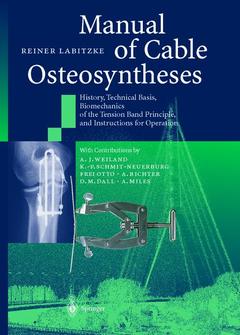1 Introduction.- 2 Brief History of Wires and Cables in Medicine and Technology.- 2.1 Conventional Binding Wire.- 2.1.1 Bone Suture: The Original Form of Osteosynthesis.- 2.1.2 Chronology of Osteosyntheses.- 2.1.3 Experiences with Cerclage Wire: A Critique.- 2.2 Wire Cables - State-of-the-Art Solution.- 2.2.1 A Brief Introduction, Including Valuable Technical Data.- 2.2.2 Principle of Cable Osteosyntheses.- 2.2.3 The Osteosynthesis Set.- 2.2.3.1 Wire Cables.- 2.2.3.2 Crimps.- 2.2.3.3 PE Sleeves.- 2.2.3.4 Instruments.- 3 Cerclage Wire and Wire Cables: A Comparison.- 3.1 Performance and Testing.- 3.2 Results.- 3.2.1 Tensile Strength of Cerclage Wire and Wire Cables.- 3.2.2 Tensile Strength of Twists and Cable-Crimp Connections.- 3.2.3 Tensile Strength of Bent Cerclage Wire.- 3.2.4 Evaluation of the Results.- 3.2.4.1 Cerclage Wire.- 3.2.4.2 Wire Cables.- 3.2.5 References in the Literature.- 4 Wire Cables in Everyday Hospital Life.- 4.1 Introduction.- 4.2 Technical Instructions for Operations.- 4.2.1 Tension Band Principle.- 4.2.2 Cerclage.- 4.2.3 Sleeve-Cable Combinations.- 4.2.4 Stretching and Crimping.- 4.2.5 The Final Steps.- 4.2.6 Errors and Risks.- 4.3 The Mechanics of Bone Healing.- 4.4 Biomechanic of Tension Band Principle.- 4.4.1 Tension Banding as a Technical and Osteosynthetic Principle.- 4.5 Patella Fracture.- 4.5.1 Historical Procedures.- 4.5.1.1 Closed Adjustment.- 4.5.1.2 Open Bone Suture.- 4.5.1.3 Tension Banding.- 4.5.2 Weber’s Patella Tension Band and its Biomechanical Analysis.- 4.5.3 Bilateral Cable Tension Band and its Biomechanical Analysis.- 4.6 Olecranon Fracture.- 4.6.1 Historical Procedures.- 4.6.2 Weber’s Olecranon Tension Band and its Biomechanical Analysis.- 4.6.3 Bilateral Cable Tension Band for Olecranon and Proximal Ulna Fractures.- 4.7 Ankle Joint and Pilon Fractures.- 4.7.1 Cable Tension Banding on the Medial Malleolus.- 4.8 Osseous Prominences.- 4.8.1 Trochanter Major Femoris.- 4.8.1.1 Trochanter Cable Tension Banding.- 4.8.2 Proximal Humerus and Tuberculum Majus.- 4.8.2.1 Cable Tension Banding on the Head of the Humerus and Tuberculum.- 4.8.3 Distal Humerus Fractures.- 4.8.3.1 Cable Tension Banding Shown on Epicondylus Ulnaris Avulsion.- 4.8.4 Avulsion Fracture at the Base of the Fifth Metatarsal.- 4.9 Compression Cable Osteosynthesis.- 4.9.1 Acetabulum Fractures and Dorsal Socket Avulsion Fracture.- 4.9.2 Corrective Osteotomy in the Knee Joint Region.- 4.9.2.1 Cable Osteosynthesis to Compress Valgus Tibial Head Adjustment Osteotomy.- 4.10 Cable Arthrodeses.- 4.10.1 Cable Arthrodesis of the Upper Ankle Joint.- 4.10.2 Pirogoff Amputation with Tibio-Calcaneal Cable Arthrodesis.- 4.11 Cable Cerclages.- 4.11.1 Shattering of Femur Shaft Following Total Endoprosthesis.- 4.12 Sleeve-Cable Banding of Unstable Pelvic Ring Injuries.- 4.13 Sleeve-Cable Osteosynthesis of Longitudinal Sternotomy.- 4.14 Soft Tissue Trauma - Temporary Protection of Ligament Sutures Using a Cable.- 4.14.1 Rupture of the Ligamentum Patellae, Quadriceps, and Achilles Tendon.- 4.14.1.1 Ligamentum Patellae.- 4.14.1.2 Quadriceps Tendon.- 4.14.1.3 Achilles Tendon.- 4.14.1.4 Ligamentum Patellae.- 4.14.1.5 Quadriceps Tendon.- 4.14.1.6 Achilles Tendon.- 4.14.2 Rupture of the Anterior Cruciate Ligament: Treatment According to Weigand.- 4.15 Special Indications.- 5 Review and Outlook.- References.


